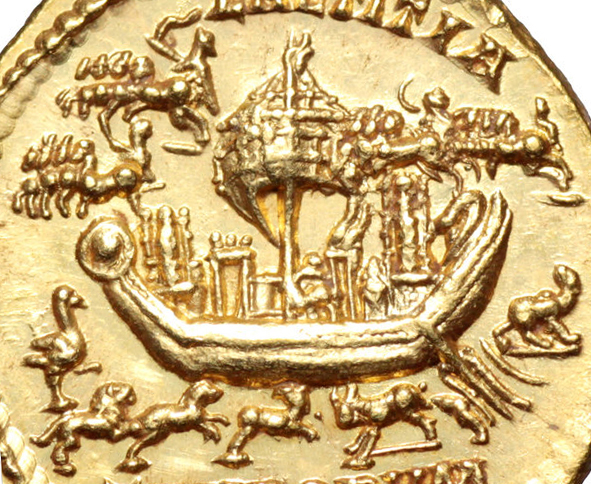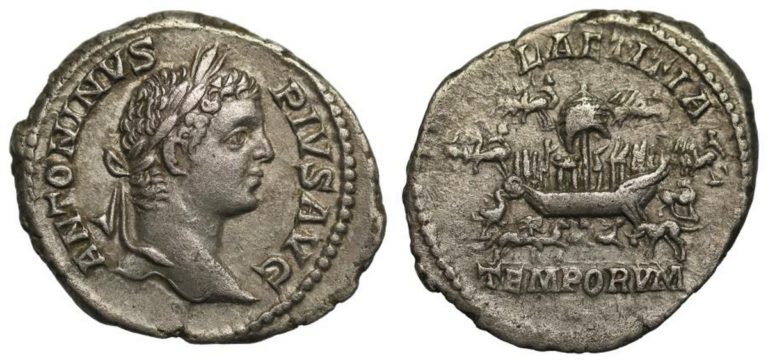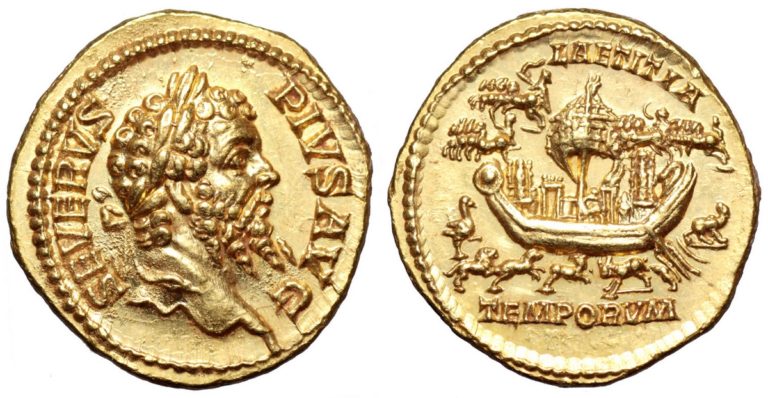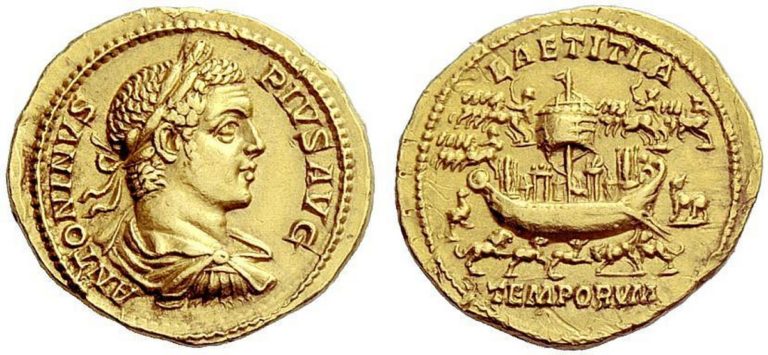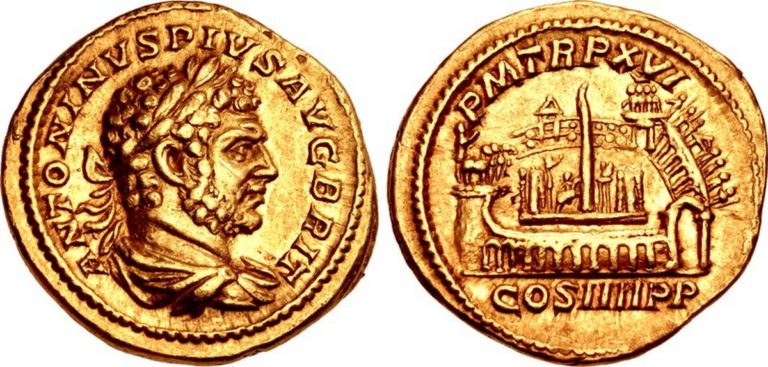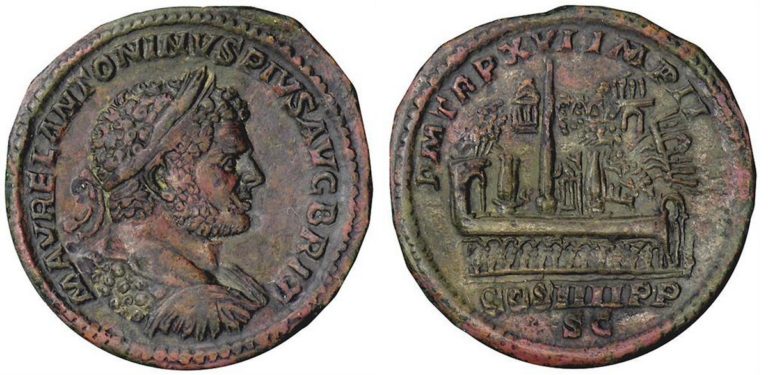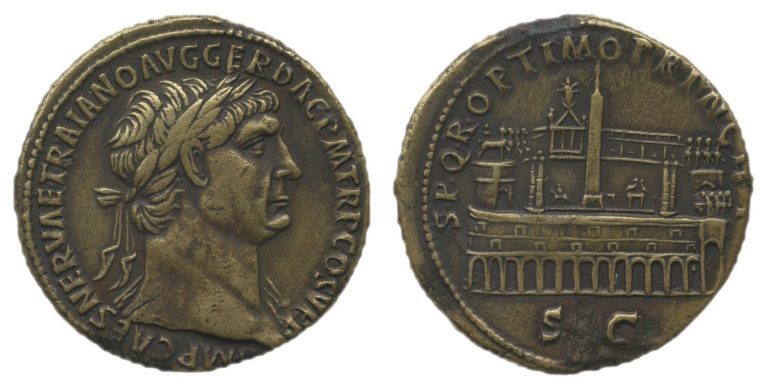Photo Copyright Roma Numismatics Ltd
When this coin (Caracalla - RIC IV 157) popped up in my email I just had to find out more. After all, it’s not every day you find a coin that has a ship, an ostrich, a bear, some lions, an ass, a panther, a bison, and racing chariots on it.
Coins showing the Circus Maximus
The coin in question is a silver denarius of Caracalla, minted to celebrate the Secular Games held in 204 AD. The reverse shows the Circus Maximus, with two events overlaid.
Photo Copyright Sovereign Rarities Ltd (£1800 – July 2018). One sold in 2003 for £505 + fee
The first event is a chariot race, which is what the circus was built for. If you’ve ever watched Ben Hur, then you’ll know what they were like. The second event is described by Dio Cassius (LXXVII) as:
The entire receptacle in the amphitheatre had been constructed so as to resemble a boat in shape, and was capable of receiving or discharging four hundred beasts at once; and then, as it suddenly fell apart, there came rushing forth bears, lionesses, panthers, lions, ostriches, wild asses, bisons …, so that seven hundred beasts in all, both wild and domesticated, at one and the same time were seen running about and were slaughtered
While beautiful in silver, it’s simply stunning in gold. Both Septimius Severus (RIC IV 274) and his son Caracalla (RIC IV 133) issued Aurei as well. The Aureus of Septimius Severus is number 87 in Harlan J. Berk’s “100 Greatest Ancient Coins”.
Photo Copyright Roma Numismatics Ltd. Auction IV, lot 574. £190,000 + fees. Oct 2012
Photo Copyright Numismatica Ars Classica NAC AG. Auction 52, lot 516 75,000 Swiss Francs + fees. Oct 2009
These coins show the “Spina” (the spine which ran along the centre of the circus) made up to look like a ship, with a sail, sides, bow, and stern. Along the bottom (from left to right) are an ostrich, a lion, a lioness, an ass, a bison being attacked by a panther (easier to see on RIC IV 133 above), and a bear. Some of the animals get different names depending on who’s selling the coin (for example, tiger, bull, zebra).
On the spina itself, from left to right we can see:
- A “metae” which is a group of three conical columns where the charioteers turned.
- A column supporting (seven) eggs which were used to count off the laps
- ?
- The obelisk of the Pharaoh Ramesses the Great in the middle made to look like a sail
- A statue of Cybele riding a lion
- A column supporting (seven) dolphins which were used to count off the laps
- An equestrian statue of Trajan (possibly)
- The other “metae”
Above the spina we can see four racing quadriga (chariots).
These aren’t the only Roman coins featuring the Circus Maximus. Caracalla renovated the Circus in 213 AD and issued an Aureus (RIC IV 211B) and four Sestertii (RIC IV 500 (a, b, c & d)) to mark the reopening:
Photo Copyright Classical Numismatic Group, LLC. Triton XX, Lot 800. $140,000 + fees. Jan 2017
Photo Copyright Stack's Bowers. The Golden Horn Collection, lot 2325. $10,925 + fees. Jan 2009
Photo Copyright Numismatica Ars Classica NAC AG Auction 59, lot 1053. 190,000 Swiss Francs + fees April 2011. This is number 31 in Harlan J. Berk’s “100 Greatest Ancient Coins“
These coins show the Circus as it would be seen from the Palatine Hill. The “Spina” runs along the centre with the obelisk of the Pharaoh Ramesses the Great in the middle. At each end of the spina are the “metae” (the groups of three conical columns where the charioteers turned). An equestrian statue of Trajan and a shrine of Cybele can be found immediately to the left and right of the obelisk, respectively (although if the statue of Trajan appears on the Sestertius, I can’t see it).
In the foreground and to right are arcades and an arched gate. The carceres (starting gates) can be seen on the right, and opposite them on the left, the semicircular end of the structure. This has the triumphal arch of Titus which can be seen here by the statues that were on top of it. The temple of Sol and Luna is visible on the back left of the structure, in the seats and to the left of the obelisk. A picture might help here.
The arch on the bottom right should have a quadriga group (chariots) on top like the one at the back right, but that would obscure the view of the carceres, and that was the main feature that Caracalla updated.
The Sestertius also manages to find space for some racing chariots.
In 103 AD, around 100 years before these coins were minted, Trajan also minted a Sestertius (RIC II 571) commemorating the re-opening of the Circus Maximus. He had just rebuilt the entire circus in stone after it had burnt down again in 80 AD.
Photo Credit : Christopher Gardner
You can see the quadriga group present on both towers on the right in this coin, and triumphal arch of Titus is more easily seen.
Coins related to the Circus Maximus
There are some miscellaneous coins related to the Circus Maximus that you can check out if you are interested:
- Trajan had two other sestertii (RIC II 553 & RIC II 554) which show the Genius of the Circus, which is a protective spirit of the place (Genius Loci). Hadrian also had coins with the Genius of the Circus on them – RIC II 144 (Aureus) and RIC II 609 (Sestertius). The Aureus is number 66 in Harlan J. Berk’s “100 Greatest Ancient Coins”. It’s notable as one of only two Roman coins that had the actual date on it
- RIC II 581 is an AS from Trajan which shows a column in the form of a club set on a lion skin on a low pedestal. This has been described as representing one of the turning marks in the Circus, although that might be the fancy of a dealer trying to increase the price.
- There is an Aureus of Caracalla (RIC IV 130B) that has nothing directly to do with the Circus Maximus, except that the statue of Dea Caelestis (also equated with Cybele) on the reverse appeared on the roof of the shrine of Magna Mater on the spina of the Circus Maximus
- There is an Aureus of Septimius Severus (RIC IV 260) described as “View of Circus, showing gate and colonnade, etc.; inside, spectators and combatants”. It’s not clear if this is meant to be the Circus Maximus, or another Circus. There’s no spina, obelisk or quadriga, and the mention of combatants suggest it might be another circus
Non-coins showing the Circus Maximus
There is a series of Contorniate’s minted in the 4th or 5th century AD that feature the Circus Maximus:
- BMC 1853,0105.189: Laureate and cuirassed bust of Caracalla
- BMC R.4822 (no photo): Laureate head of Augustus
- BMC R.5026: Laureate head of Nero
- MFA Boston 68.164: Laureate head of Trajan
- MFA Boston 13.1695: Bust of Alexander, wearing lion’s skin
- Roma Numismatics 47 lot 663: Bust of Divus Trajan
And finally, there’s a medallion from Gordian III that I can find absolutely no information on other than a scan from a book which you can find here:

